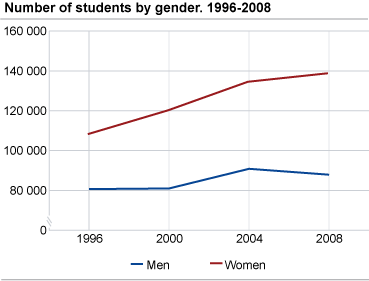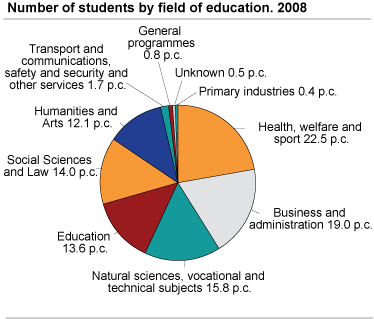Content
Published:
This is an archived release.
Largest increase in university colleges
A total of 225 400 students in Norway and Norwegian students abroad were registered in tertiary education in 2008; 6 000 more than in 2007. The majority of new enrolments were from business and administration studies.
The number of students at public university colleges rose from 85 400 in 2007 to 88 150 in 2008, while the number of students at the specialised School of Management rose from 18 250 to 19 700. The increase in student registrations at public university colleges and the specialised School of Management represented about 70 per cent of the growth in total enrolments. Universities accounted for 85 200 of enrolments, rising by 400 from 2007. The University of Oslo and the University of Bergen had a decline in student numbers. Overall enrolment in the Universities of Oslo and Bergen dropped by more than 18 per cent from 1998 to 2008.
Female students accounted for 61 per cent of all registrations in 2008. Corresponding proportions at public university colleges and the Norwegian School of Management (BI) were 66 and 52 per cent respectively. At the county level, students who lived in Oslo at the age of 16 had the lowest proportion of female students. The largest proportion of females was found in the group of students living in Finnmark.
How students are registeredEach student is counted once even if he/she is registered in several educational activities or is registered in more than one educational institution. For more information on the control and revision process, see About the statistics. |
Enrolment up in health, welfare and sport as well as in business and administration studies
There was a growth in almost every field of study in 2008. The only major field to register a decline was Teacher training and pedagogy. The top two fields of study by number of registrants (health, welfare and sport; and in business and administration) accounted for over 36 per cent of the total enrolment in 2008. A record 50 350 students were registered in health, welfare and sport, up 1 800 from the previous year. This field of study accounted for 30 per cent of the total growth in the number of students. The field of health, welfare and sport also had the largest proportion of female students with around 80 per cent.
The number of students in Business and Administration studies reached 42 550, up 3100 from the previous year. Since 1998, enrolment in this field of studies has risen by nearly 35 per cent, partly due to the increased participation of women. Woman accounted for almost 56 per cent of all students in this field in 2008. The third largest field of study was Natural Sciences, Vocational and Technical subjects, where enrolment reached 35 400 in 2008.
Norwegian students abroad
Norwegian students studying abroad accounted for 5 per cent of the tertiary education population in 2008, a proportion that remained steady compared with the records from the previous year. However, there were changes with regard to the distribution of Norwegian student registrations abroad. Most non-English speaking countries saw a drop in enrolment figures for the benefit of Great Britain and Denmark, traditionally the most popular study destinations among Norwegian students. The gain in registration in these destinations rose by 219. Poland also continued to register significant numbers of students from Norway.
Tables:
- Table 1 Students in tertiary education in Norway and Norwegian students abroad by gender, type of college, ownership and educational institution. 1 October 1998, 2007 and 2008
- Table 2 Students in tertiary education in Norway and Norwegian students abroad, by gender, age and type of college. Absolute figures and per cent. 1 October 2008
- Table 3 Students in tertiary education in Norway and Norwegian students abroad by gender and field of education. 1 October 1998, 2007 og 2008
- Table 4 Students in Norway and Norwegian students abroad, by county of residence at the age of 16. 1 October 1998 and 2008. Percentage women
- Table 5 Norwegian students in tertiary education abroad, by gender and Countries of destination. 1 October 1998, 2007 and 2008
Contact
-
Geir Nygård
E-mail: geir.nygard@ssb.no
tel.: (+47) 48 15 13 44
-
Maj-Lisa Lervåg
E-mail: maj-lisa.lervag@ssb.no
tel.: (+47) 45 68 84 72


